 Palo Alto-based Neurotrack, which has developed an online cognitive assessment test, raised $6.5 million in a round led by Khosla Ventures with participation from Social Capital, Founders Fund, AME Cloud Ventures, and iSeed Ventures. This brings Neurotrack’s total funding to $9.5 million.
Palo Alto-based Neurotrack, which has developed an online cognitive assessment test, raised $6.5 million in a round led by Khosla Ventures with participation from Social Capital, Founders Fund, AME Cloud Ventures, and iSeed Ventures. This brings Neurotrack’s total funding to $9.5 million.
Neurotrack has developed two offerings. The first is a five minute, web-based test, called Imprint Cognitive Assessment Test that evaluates whether a patient is at risk for Alzheimer’s. The research behind the technology began in a lab at UCSD, Neurotrack Cofounder and CEO Elli Kaplan told MobiHealthNews.
One of the company’s scientific founders Stuart Zola, made an early discovery in Alzheimer’s — that the disease begins in the hippocampus, a part of the brain. Zola spent almost a year researching this in nonhuman primates. The research culminated in a five-year longitudinal study that was done at Emory Alzheimer's Disease Research Center.
Kaplan met Zola and the other researchers around that time, and in May 2012, they formed Neurotrack, joined Rock Health’s accelerator, and licensed the technology from Emory. About a year later, Neurotrack raised a seed round.
“After we raised capital, we spent a considerable amount of time really improving and enhancing the technology,” Kaplan said. “When we first licensed it from Emory it was a 30-minute long test, it required an $85,000, very expensive, very sophisticated piece of eye tracking hardware. In the first nine months or so, we were able to reduce the time of the test from 30 minutes to five minutes and get rid of the need for the eye tracking device. Now we can do all of our eye tracking through the web camera.”
Patients can take the test in-person with the doctor or remotely, but Kaplan explained that Neurotrack is also working with pharmaceutical and biotech companies, which are interested in using the product to determine whether certain people are right for clinical trials for Alzheimer’s drugs.
Users who take the test are first shown a blue dot that travels around the screen. During this period of time, the web camera really calibrates to the user’s particular eye movement. The test then starts to show users identical pairs of images to a baseline for the exam. She explained the identical images are imprinted into the user’s memory. Finally, users start to see novel images, which is when the real testing begins.
“We are assessing the health of your hippocampus,” Kaplan explained. “We are trying to understand where are you looking, what are you looking at, and what are you curious about. How much time do you spend looking at images you have already seen before? How much time are you looking at ones that you’ve never seen before? And [we're] collecting as much data around that as possible. Once the test is complete, all of that data will get uploaded to our server. We have very complex algorithms that are built on assessing your novelty processing and curiosity. And then we get the score.”
The company’s other product, which will work in conjunction with Imprint, is a web or app-based cognitive health intervention program that aims to help improve a user’s cognitive health. The offering will launch in private beta next month and in the spring, Kaplan said Neutrotrak will begin a clinical study with a cohort of 300 people to test the offering.
While many are focused on finding a drug for Alzheimer's, Kaplan said there's other important work to be done too.
“As a result of this focus on getting to a drug, finding a drug — which is incredibly important, and we don’t want to lose sight of it — we have overlooked a really important body of scientific evidence coming out of Europe, US, other places that have shown that it’s possible to actually prevent cognitive decline using very specific changes in diet, exercise, cognitive training, managing your sleep, and managing your stress levels,” Kaplan said.
Diseases like Alzheimer’s, she explained, begin 20 to 25 years before one experiences symptoms. Kaplan explained that consumers can do a lot more to improve their brain health in this period of time before irreversible damage takes place.
The company plans to first provide users with a questionnaire that asks a number of questions including what does the user’s life looks like, what is their gender, where do they live, what’s their diet like, and how much sleep are they getting. From there, the tool can give users specific recommendations of what kinds of exercises to do and food to eat as well as provide them with cognitive training tools.
In the future, this product will also integrate data from third party health apps and tracking devices.















